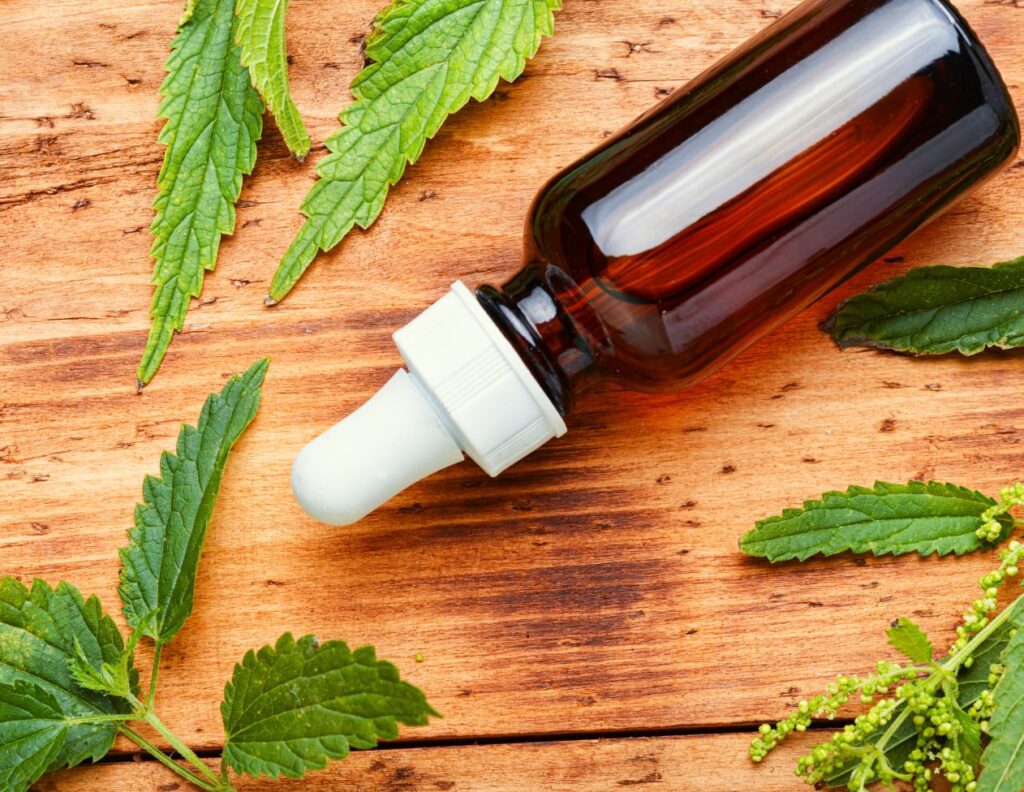Want to learn how to make nettle tincture and use this ancient medicine at home? Continue reading and find out.
Nettle tincture (Urtica dioica) is one of the most powerful diuretics, reduces kidney and urinary tract inflammation, diminishes or eliminates stinging and pain when urinating, and helps rebuild healthy cells. But before we show you how to make nettle tincture, here is how to harvest nettle roots, leaves and stems to prepare the nettle tincture.

In This Article You Will Find:
How to Harvest Nettle for Tincture
Nettle roots are harvested either in early spring or in late autumn, after the first frosts, in the month of November. Dig it up with a spade, wash it in a fast stream of water, and leave it to dry in a warm room (if possible, exposed to sunlight – near the window). Dry the nettle root in a thin layer, on wooden frames, sheets of paper, or mats, in airy and well-ventilated spaces (atticks, verandas, balconies).
When they are dried, the nettle roots become very brittle and break with a dry crack. After drying, store the nettle roots in gauze bags, paper bags, cardboard boxes, or raffia bags. Keep the root whole, until the moment of processing. Grind the root in small pieces just before use and then store it in canvas bags, in cool and dry places.
Nettle leaves, flowers, and stems are harvested in the plant’s maturity phase, that is, between July and November.
Did you know? The stinging nettle “sting” is caused by formic acid, an enzyme and a toxin.
How to Make Nettle Tincture
Soak 2 tablespoons of dry and coarsely chopped nettle roots or leaves in 100 ml of 60-degree food alcohol (extracting the active principles from the nettle root requires a higher alcohol concentration) in a sealed glass jar. Leave to macerate for 10 days, shaking 3-4 times a day. Strain the tincture through cheesecloth, and pour it into another clean glass jar in the fridge to decant. After another 6 days, gently transfer the clear part of the tincture into small amber bottles with a dropper, leaving out any residue that has settled on the bottom of the jar. The shelf life of the nettle tincture is 2 years from the date of preparation. Shake the bottle before each use.
If you cannot have any alcohol, you can replace the tincture with the combined nettle decoction (900 – 1200 ml/day).
How to Use Nettle Tincture
- Cystitis, nephritis, pyelonephritis – The tincture from nettle leaves, stems, and possibly flowers or seeds – 6 teaspoons throughout the day (each tsp. diluted in 100 ml of water) for 30 days. For even better results, combine nettle with juniper and yarrow.
- Depurative – 30 drops, 3 times a day, into a cup of ginkgo biloba or periwinkle leaves tea (Vinca minor).
- High blood pressure – 30 drops, 3 times a day, into a cup of ginkgo biloba or periwinkle leaves tea (Vinca minor).
- Hemorrhoids – 30 drops, 3 times a day, into a cup of ginkgo biloba or periwinkle leaves tea (Vinca minor).
- Nose bleeds – 30 drops, 3 times a day, into a cup of couch grass root tea (Elymus repens).
- Low immunity – 30 drops, 3 times a day.
- Anemia – 30 drops, 3 times a day, into a cup of wormwood tea (Artemisia absinthium).
- Varicose veins – 30 drops, 3 times a day, into a cup of Sophora Japonica flower bud tea (Styphnolobium japonicum).
- Diabetes adjuvant – 30 drops, 3 times a day.
- Prostate adenoma – 50 drops, 3 times a day, added to a cup of heartsease tea (Viola tricolor).
- Gastric problems due to smoking – 50 drops, 3 times a day, added to a cup of heartsease tea (Viola tricolor).
- Allergies – 50 drops, 3 times a day, added to a cup of heartsease tea (Viola tricolor).
- Paradontosis – 30 drops, 3 times a day, added to a cup of caffeine-free herbal tea of your choice.
- Bone remineralizing – 30 drops, 3 times a day, into a cup of common knotgrass tea (Polygonum aviculare).

Nettle Side Effects and Contraindications
Before using stinging nettle preparations or remedies, consult your specialist doctor or herbalist, especially if you also use synthetic drugs or medication. Nettle leaves practically have no adverse effects and contraindications, being considered among the safest known herbal remedies, because their use has been very long and well observed. However, there are some recommendations.
- Fresh nettle is used with caution in the case of thrombosis, under medication, in which case the high vitamin K content of nettle causes an increase in the blood coagulation speed.
- Limit its use to a minimum in case of thrombophlebitis, and blood circulation problems, especially in the elderly.
- Nettle is not used in case of internal bleeding caused by myoma, ovarian cysts, or acute kidney diseases.
- Nettle juice and diuretic preparations with nettle should be used with care in cases of acute kidney and liver inflammatory processes, but also in acute kidney or heart failure.
- In pregnant women, in some cases, nettle can cause miscarriages.
- Nettle preparations lower blood pressure, therefore it is contraindicated while taking antihypertensive drugs.
- Do not use nettle remedies in combination with antidepressants and sleeping pills, because it can affect the central nervous system.
Read Also: How to Make Nettle Root Decoction
If you’ve enjoyed learning how to make nettle tincture at home and what to use nettle tincture for, please share this article. This way we can reach more people and empower them with this basic information on the health uses of nettle tincture. Stay healthy, naturally!
Share on Pinterest ❤️

